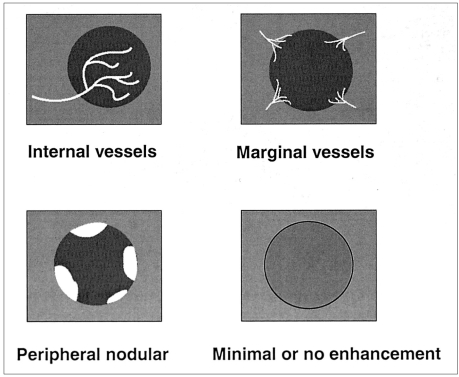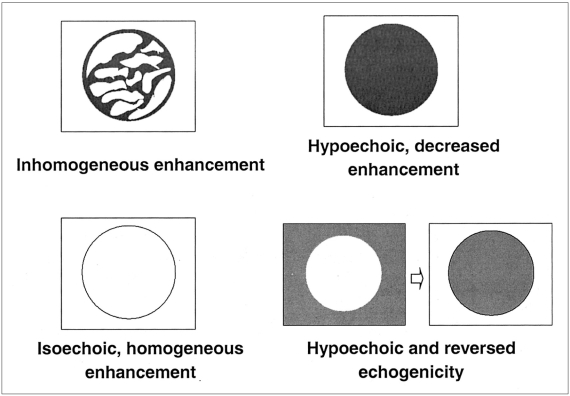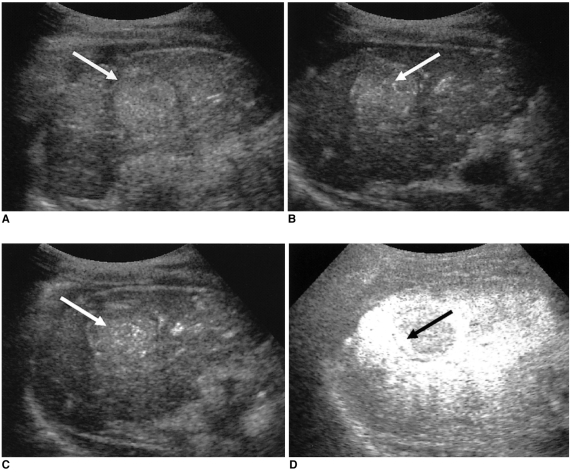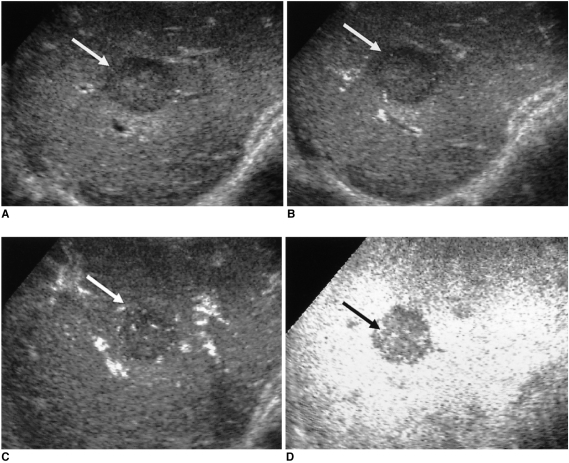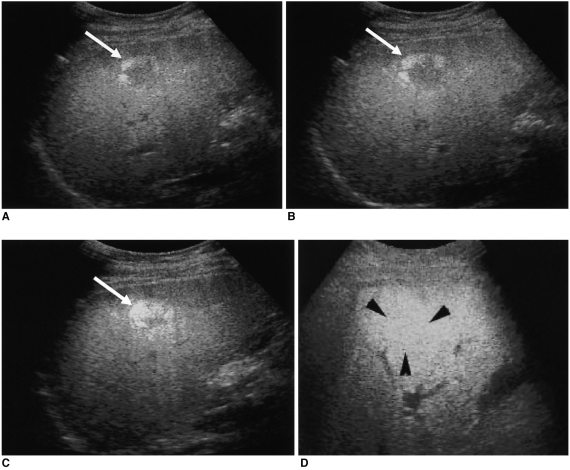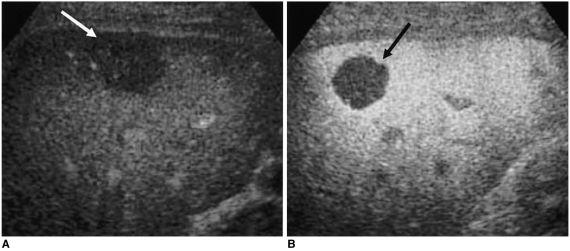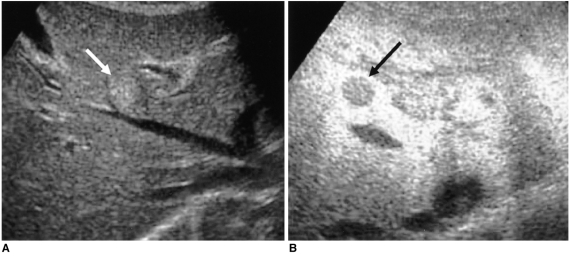Korean J Radiol.
2003 Dec;4(4):224-233. 10.3348/kjr.2003.4.4.224.
Focal Hepatic Lesions: Contrast-Enhancement Patterns at Pulse-Inversion Harmonic US using a Microbubble Contrast Agent
- Affiliations
-
- 1Department of Radiology and Institute of Medical Science, Wonkwang University School of Medicine. yoonkh@wmc.wonkwang.ac.kr
- KMID: 1111251
- DOI: http://doi.org/10.3348/kjr.2003.4.4.224
Abstract
OBJECTIVE
To analyze the contrast-enhancement patterns obtained at pulseinversion harmonic imaging (PIHI) of focal hepatic lesions, and to thus determine tumor vascularity and the acoustic emission effect. MATERIALS AND METHODS: We reviewed pulse-inversion images in 90 consecutive patients with focal hepatic lesions, namely hepatocellular carcinoma (HCC) (n=43), metastases (n=30), and hemangioma (n=17). Vascular and delayed phase images were obtained immediately and five minutes following the injection of a microbubble contrast agent. Tumoral vascularity at vascular phase imaging and the acoustic emission effect at delayed phase imaging were each classified as one of four patterns. RESULTS: Vascular phase images depicted internal vessels in 93% of HCCs, marginal vessels in 83% of metastases, and peripheral nodular enhancement in 71% of hemangiomas. Delayed phase images showed inhomogeneous enhancement in 86% of HCCs; hypoechoic, decreased enhancement in 93% of metastases; and hypoechoic and reversed echogenicity in 65% of hemangiomas. Vascular and delayed phase enhancement patterns were associated with a specificity of 91% or greater, and 92% or greater, respectively, and with positive predictive values of 71% or greater, and 85% or greater, respectively. CONCLUSION: Contrast-enhancement patterns depicting tumoral vascularity and the acoustic emission effect at PIHI can help differentiate focal hepatic lesions.
Keyword
MeSH Terms
-
Adult
Aged
Carcinoma, Hepatocellular/blood supply/*ultrasonography
Colon/pathology
Contrast Media/*administration & dosage
Diagnosis, Differential
Female
Hemangioma/blood supply/*ultrasonography
Human
Image Enhancement/*methods
Liver/pathology/ultrasonography
Liver Neoplasms/blood supply/secondary/*ultrasonography
Lung/pathology
Male
*Microbubbles
Middle Aged
Pancreas/pathology
Polysaccharides/administration & dosage/diagnostic use
Reproducibility of Results
Retrospective Studies
Sensitivity and Specificity
Stomach/pathology
Support, Non-U.S. Gov't
Figure
Reference
-
1. Choi BI, Kim TK, Han JK, Chung JW, Park JH, Han MC. Power versus conventional color Doppler sonography: comparison in the depiction of vasculature in liver tumors. Radiology. 1996; 200:55–58. PMID: 8657945.
Article2. Lencioni R, Pinto F, Armillotta N, Bartolozzi C. Assessment of tumor vascularity in hepatocellular carcinoma: comparison of power Doppler US and color Doppler US. Radiology. 1996; 201:353–358. PMID: 8888222.
Article3. Burns PN. Harmonic imaging with ultrasound contrast agents. Clin Radiol. 1996; 51:50–55. PMID: 8605774.4. Goldberg BB, Liu J, Burns PN, Merton DA, Forsberg F. Galactose-based intravenous sonographic contrast agent: experimental studies. J Ultrasound Med. 1993; 12:463–470. PMID: 8411330.
Article5. Cosgrove D. Why do we need contrast agents for ultrasound? Clin Radiol. 1996; 51:1–4. PMID: 8605763.6. Schineider M, Broillet A, Bussat P, et al. Gray-scale liver enhancement in VX2 tumor-bearing rabbits using BR14, a new ultrasonographic contrast agent. Invest Radiol. 1997; 32:410–417. PMID: 9228607.7. Forsberg F, Goldberg BB, Liu J, Merton DA, Rawool NM, Shi WT. Tissue-specific US contrast agent for evaluation of hepatic and splenic parenchyma. Radiology. 1999; 210:125–132. PMID: 9885597.
Article8. Hauff PD, Fritzsch TD, Reinhardt M, et al. Delineation of experimental liver tumors in rabbits by a new ultrasound contrast agent and stimulated acoustic emission. Invest Radiol. 1997; 32:94–99. PMID: 9039581.
Article9. Kono Y, Moriyasu F, Nada T, et al. Gray scale second harmonic imaging of the liver: a preliminary animal study. Ultrasound Med Biol. 1997; 23:719–726. PMID: 9253819.
Article10. Burns PN, Wilson SR, Simpson DH. Pulse inversion imaging of liver blood flow: improved method for characterizing focal masses with microbubble contrast. Invest Radiol. 2000; 35:58–71. PMID: 10639037.11. Wilson SR, Burns PN, Muradali D, Wilson JA, Lai X. Harmonic hepatic US with microbubble contrast agent: initial experience showing improved characterization of hemangioma, hepatocellular carcinoma, and metastasis. Radiology. 2000; 215:153–161. PMID: 10751481.
Article12. Blomley MJK, Albrecht T, Cosgrove DO, et al. Improved imaging of liver metastases with stimulated acoustic emission in the late phase of enhancement with the US contrast agent SH U 508A: early experience. Radiology. 1999; 210:409–416. PMID: 10207423.
Article13. Dalla-Palma L, Bertolotto M, Quaia E, Locatelli M. Detection of liver metastases with pulse-inversion harmonic imaging: preliminary results. Eur Radiol. 1999; 9:S382–S387. PMID: 10602934.14. Kim TK, Choi BI, Han JK, Hong HS, Park SH, Moon SG. Hepatic tumors: contrast agent-enhancement patterns with pulse-inversion harmonic US. Radiology. 2000; 216:411–417. PMID: 10924562.
Article15. Jang HJ, Lim HK, Lee WJ, et al. Focal hepatic lesions: evaluation with contrast-enhanced gray-scale harmonic US. Korean J Radiol. 2003; 4:91–100. PMID: 12845304.
Article16. Dill-Macky MJ, Burns PN, Khalili K, Wilson SR. Focal hepatic masses: enhancement patterns with SH U 508A and pulse-inversion US. Radiology. 2002; 222:95–102. PMID: 11756711.
Article17. Albrecht T, Hoffmann CW, Schmitz S, et al. Phase-inversion sonography during the liver-specific late phase of contrast enhancement: improved detection of liver metastases. AJR Am J Roentgenol. 2001; 176:1191–1198. PMID: 11312180.18. Blomley MJK, Albrecht T, Cosgrove DO, et al. Stimulated acoustic emission to image a late liver and spleen-specific phase of Levovist® in normal volunteers and patients with and without liver disease. Ultrasound Med Biol. 1999; 25:1341–1352. PMID: 10626621.
Article19. Ko CJ, Yoon KH. Gray-scale stimulated acoustic emission: differential diagnosis between hepatocellular carcinoma and metastatic adenocarcinoma. J Korean Radiol Soc. 2001; 44:63–68.
- Full Text Links
- Actions
-
Cited
- CITED
-
- Close
- Share
- Similar articles
-
- The Detectability of Hepatic Metastases in Candidates of Radiofrequency Ablation: Comparison for Helical CT Scanning and Late-Phase Pulse-Inversion Harmonic Imaging
- Detection of Hepatic VX2 Tumors in Rabbits: Comparison of Conventional US and Phase-Inversion Harmonic US During the Liver-Specific Late Phase of Contrast Enhancement
- Hepatic Hemangiomas: Spectrum of US Appearances on Gray-scale, Power Doppler, and Contrast-Enhanced US
- Focal Hepatic Lesions: Evaluation with Contrast-Enhanced Gray-Scale Harmonic US
- The Study of Renal Perfusion Image in Rabbit by Harmonic Ultrasound with Microbble Contrast Agent in Comparison with 99mTc-DTPA: Focusing on US Scan Technique and Concentration of Contrast Agent

